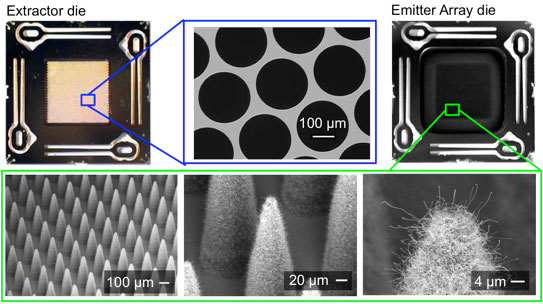 The paper "High-Throughput Ionic Liquid Ion Sources Using Arrays of Microfabricated Electrospray Emitters with Integrated Extractor Grid and Carbon Nanotube Flow Control Structures", by F. A Hill, E. V. Heubel, P. Ponce de Leon, and L. F. Velásquez-García was selected as one of the three JMEMS RightNow Papers of the October 2014 issue of the IEEE Journal of Microelectromechanical Systems (JMEMS), arguably the top journal on the topic of MEMS/NEMS. The distinction recognizes the excellent quality of the paper, effectively ranking it in the top 10% of the papers that compose the bi-monthly issue. The recognition awards Open Access to the paper (i.e., free download of the paper from the IEEE servers) to greatly enhance the dissemination of the work into the research community. The paper can be downloaded here http://ieeexplore.ieee.org.ezproxy.canberra.edu.au/xpl/articleDetails.jsp?arnumber=6816025
The paper "High-Throughput Ionic Liquid Ion Sources Using Arrays of Microfabricated Electrospray Emitters with Integrated Extractor Grid and Carbon Nanotube Flow Control Structures", by F. A Hill, E. V. Heubel, P. Ponce de Leon, and L. F. Velásquez-García was selected as one of the three JMEMS RightNow Papers of the October 2014 issue of the IEEE Journal of Microelectromechanical Systems (JMEMS), arguably the top journal on the topic of MEMS/NEMS. The distinction recognizes the excellent quality of the paper, effectively ranking it in the top 10% of the papers that compose the bi-monthly issue. The recognition awards Open Access to the paper (i.e., free download of the paper from the IEEE servers) to greatly enhance the dissemination of the work into the research community. The paper can be downloaded here http://ieeexplore.ieee.org.ezproxy.canberra.edu.au/xpl/articleDetails.jsp?arnumber=6816025
The paper reports the demonstration of high-throughput ionic liquid electrospray ion sources with ten times larger per-emitter current and 4 times larger array size and emitter density than the best reported values in the literature. In order to achieve this, the team developed massive and dense arrays of microfabricated surface tension-fed electrospray emitters that use carbon nanotube (CNT) forests to regulate and uniformize the emission across the array; by carefully tuning the morphology of the forests, the researchers were able to get as close as possible to the maximum theoretical flow rate per emitter, which is the minimum flowrate that can sustain stable droplet emission -a value given by the physical properties of the liquid. In a nutshell, the electrospray emitters produce the current levels of ionic liquid droplet emitters while still producing only ions. The device implements a hierarchical structure that brings together optimized features with associated characteristic lengths that span five orders of magnitude: mesoscale deflection springs for precision assembly of the emitter and extractor electrode dies to attain low beam interception, microsharp emitter tips for low-voltage electrospray emission, and a nanostructured conformal CNT forest that acts as a wicking structure to control the flow rate fed to each emitter and enforce array emission uniformity. The work is of great importance to applications such as low-temperature large-area nanomanufacturing, mass spectrometry of liquids, and nanosatellite propulsion.
--Microsystems Technology Laboratories